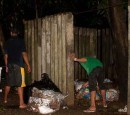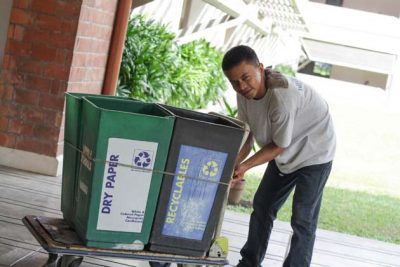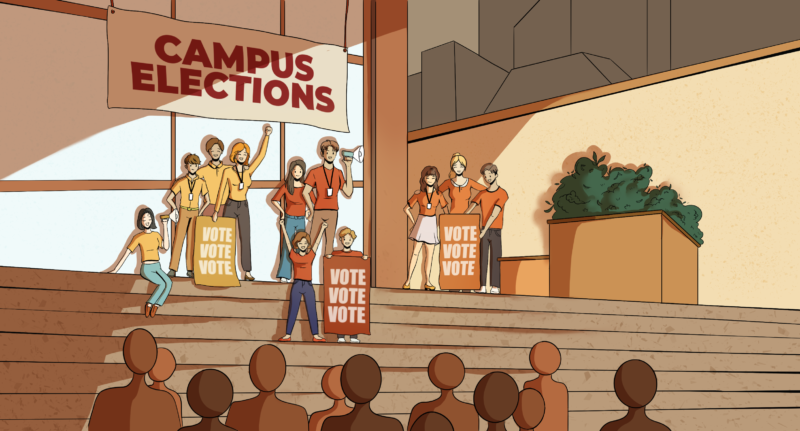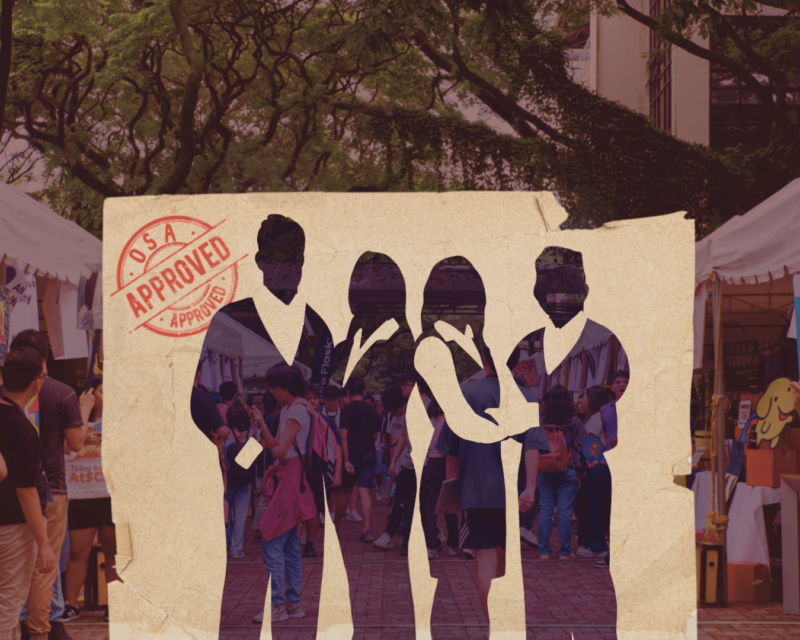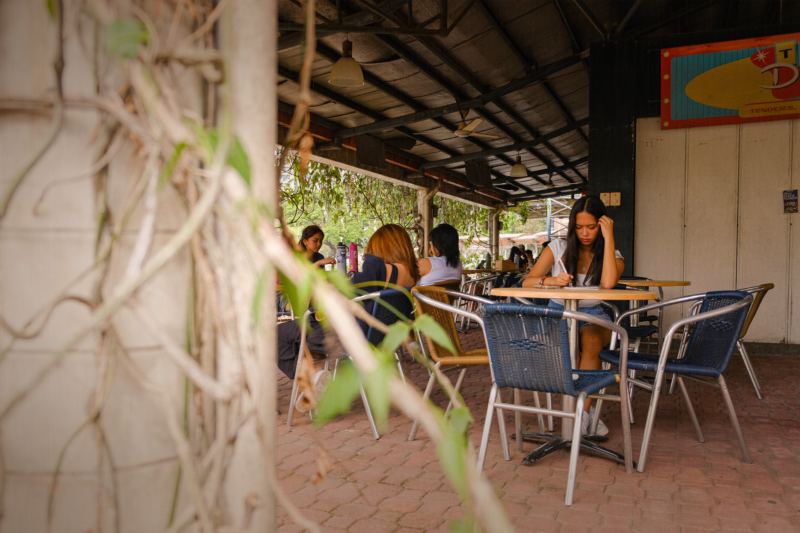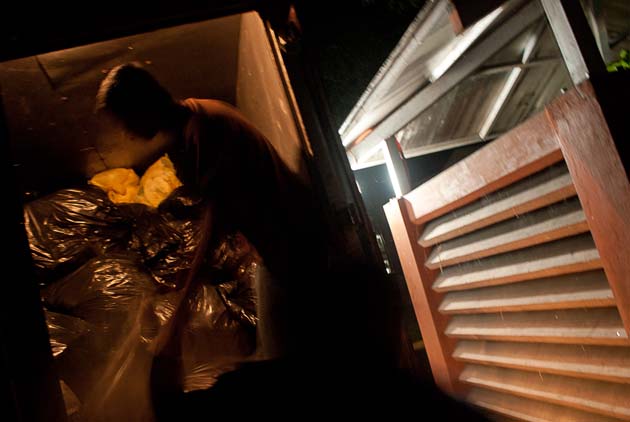
TWILIGHT. The university's trash is collected during the early hours of the morning. Photo by Adrian F. Begonia
It is idealistic at best for one to believe that the long-term issue of climate change will come to an ultimate end as soon as humanity discovers a final solution. The reality, however, is in the fact that hundreds of millions of dollars in funding and countless years of research have all pointed toward a more somber outlook: that climate change is irreversible.
A grim forecast
Although climate change has been a natural occurring phenomenon in the Earth’s natural order from the very beginning, contemporary society is faced with an abnormality caused by humanity’s artificial impact on the atmosphere. It seems that nature did not foresee the exponential rise of a world order that would pave the way for entire societies to devour colossal amounts of resources, generate massive amounts of waste and consume energy at unprecedented rates.
The Philippines itself has not been exempt from the force of extreme weather. The archipelago’s position right beside the Pacific Ocean has made it susceptible to an annual onslaught of monsoons and typhoons. Although weather disturbances are a normal occurrence in Filipino life, and society has shown resiliency to such phenomena, scientific models indicate that the force of nature will wreak greater havoc over the coming years.
Research published by Greenpeace, for example, points out that between the years 1970 to 2000, the Philippines experienced five episodes of the La Niña weather phenomenon and seven of the El Niño. This stands in stark contrast to three La Niña episodes and two El Niño episodes between 1950 and 1970.
It seems that contemporary society is already being tested to the limit of its resiliency. A 2005 study co-authored by university president and environmental scientist Fr. Jose Ramon Villarin, SJ explains that the country “will not be spared of the adverse impacts of sea-level rise and extreme climate events that are expected to happen in a warmer world.” Such a statement accurately foresaw what was to come in the near future.
One life too many
A year after the publication of the said study, Typhoon Reming slammed into Eastern Luzon, bringing strong rain, mudslides, and flood that the former National Disaster Coordinating Council (NDCC) reported to have brought about the deaths of at least 720 people and the displacement of 95,926 individuals from Regions IV-A, IV-B and V.
In 2008, figures from the NDCC showed that at least 557 lost their lives when Typhoon Frank crashed into the Visayas region, leaving in its wake more than 13 billion pesos in damages. The storm’s path of destruction made its way through Western Visayas and pushed through all the way up to the Northern Philippines.
It was September 2009 when Typhoon Ondoy smashed into Luzon with a massive amount of rain. The Philippine Atmospheric, Geophysical, and Astronomical Services Association (Pagasa) reported 17.9 inches of rainfall in a span of 24 hours. What worsened the situation even further was the fact that the massive amount of water caused flash floods that struck residential areas at night, imperiling many individuals and leaving them in shock by morning. The NDCC reported that at least 464 people lost their lives and about 11 billion pesos worth of damages were caused by the typhoon.
Two years later, Tropical Storm Sendong barreled its way through the Southern Philippines in the middle of December. The newly renamed National Disaster Risk Reduction and Management Council (NDRRMC) tallied at least 1,257 corpses after the disaster. What made the situation even more unusual, though, was the fact that the winds of Sendong were not strong enough to be labeled a typhoon. What did most damage was the flooding itself.
The recent flooding brought about by the monsoon rains of early August this year brought the National Capital Region to a standstill with flashfloods and landslides. The NDRRMC reported that at least 89 individuals lost their lives and that more than 8,428 homes were destroyed.
Building the future
A ray of optimism stems from the fact that though society can do nothing to reverse climate change, humanity has refused to stand idly by. Such is the case in the Ateneo.
“If you look at the mission and vision statements of colleges in Manila, ours is the only one that mentions the environment. And I’m quite proud of that. [The Loyola Schools] has always had environmental policies,” explains Abigail Favis, head of the Ateneo Environmental Management Coalition and a faculty member at the Environmental Science Department.
Favis points to the integrated sustainable irrigation system of the Marian Garden between Berchmans Hall and the college chapel as a good example. In the said system, sewage water from the septic tank under the Zen Garden is naturally treated and is used to water the plants and flowers of the garden.
“If you notice during the summer, the Marian Garden is still green compared to the other surroundings in the university,” Favis says. Such a system is also in place in Matteo Ricci Hall, which uses up all its wastewater for irrigation. She adds that a centralized wastewater treatment facility is also being built right next to the college baseball field.
Room for improvement
Ateneo Environmental Science Society President Jenica Dizon believes that the university is on the right track toward a greener Earth. “During the second semester of my freshman year, disposables [Styrofoam packaging and plastic containers] were banned. The Bring Your Own Baunan deposit scheme and Clean As You Go policy were also introduced. The segregation scheme was also revised and made more comprehensive as new categories were added for easier recycling.”
Nevertheless, she points out that there is still room for improvement. “I think faculty members should accept online submissions of papers or at least give their students the option to print on used readings or scratch paper. The same goes with readings. Not all have an e-reserve copy of their required readings for class, [even though] more often than not, these readings are [for] one-time use only and are discarded at the end of the semester.”
Getting serious
Villarin recalls that during his days as a student, society still did not have an over-dependence on cars. Public transportation was a popular means of travel for car owners and non-car owners alike. “When I was in the [Ateneo] high school in the 70s, it was okay to walk. We had cars, but we’d walk all the way to della Strada where the bus station was… When I was in college, we’d exercise cross-country [in the university]: go out of Gate Three and run along Katipunan. Back then, you could still jog along the road.”
During the ‘90s, Villarin was head of the Climate Studies Division of the Manila Observatory. His field was a relatively new discipline at that time. “Most of my work was [on building] consciousness… I was giving talks to communities, I was giving talks to congressman, but no one was biting. Yes, they were worried, but people did not [get serious] until Al Gore came out with An Inconvenient Truth. That’s when I realized that media is very important. For all the science that you’ve done, it’s the communication and the packaging of the truth that also matters.”
Villarin plans to reduce the university’s carbon footprint. In last July’s Ignatian Festival, for example, electric shuttles were used to convey people around the university. He has also pointed out the possibility of adding more solar panels to the different buildings of the school. “We pay millions a month [for the electricity]… It’s almost like a little city. We’re looking at different ways to power our appliances.”
He notes, however, that technology may not be enough to save the world. His position is a call for a change in culture that goes hand in hand with the advancement of human machinery. “There is no lack of good will. There is no lack of desire… I hope we don’t tire of proposing solutions,” he says.
- DECONSTRUCTING THE HEAP. Waste segregation plays an important role in the university’s environmental policy. Photo by Alexandra L. Huang
- Photo by Adrian F. Begonia
- TWILIGHT. The university’s trash is collected during the early hours of the morning. Photo by Adrian F. Begonia
Waste not, want not
Research by Paolo M. Taruc, Infographic by Jan-Daniel S. Belmonte
Solid waste management has become a long-term issue for the country. It is in this light that in the year 2000, the Ecological Solid Waste Management Act (RA 9003) was made into a law.
Waste Composition in Metro Manila
Average Urban Filipino
0.5 kg/day
Loyola Schools Student Population: 7,391
3695.5 kg/day
Metro Manila
6.7 million kg/day
SOURCES: Department of Environment and Natural Resources (data based on 2005 statistics), Office of the Registrar

